The man in the iron lung: How Paul Alexander lived life to the full
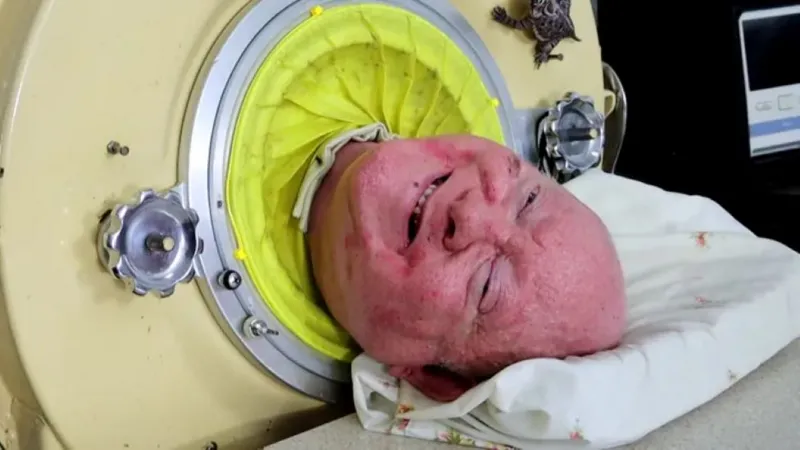
Paul Alexander was six years old when he woke, terrified, to find himself inside a large metal tube, with only his head sticking out.
He couldn’t move to feel what was trapping him, and when he tried to call for help, he discovered he couldn’t make a sound.
Paul had survived a serious bout of polio, but had been left quadriplegic. After an emergency tracheostomy operation, he was unable to breathe without the iron lung machine that now encased his small body.
When he died recently at the age of 78, Paul had spent more than seven decades using his iron lung, longer than anyone else in history.
 GoFundMe
GoFundMeBut what was it that marked him out from so many of his peers, and kept him going?
Polio ran riot in the late 19th and early 20th centuries, killing and maiming scores of children.
In hospital in Texas in 1952, Paul was surrounded by other children in similar predicaments. According to the World Health Organization, one in 200 polio infections leads to irreversible paralysis. Among those paralysed, 5-10% die when their breathing muscles become immobilised.
Uncertain future
After two years in hospital, doctors began to cast doubt on Paul’s future.
That led his parents to make the brave decision to take him and his iron lung home, to live out his days in peace. But instead of dying, Paul went from strength to strength, once he was home in his parents’ care.
The iron lung uses a negative pressure system. Powered by a motor, its bellows suck air out of the cylinder, creating a vacuum around the patient’s body and forcing the lungs to expand and take in air. When the air is let back in, the same process in reverse makes the lungs deflate. The device needs a source of energy to function.
During power cuts, the bellows had to be pumped by hand; neighbours would come to help with the job. Paul’s father designed an alarm bell that Paul could ring using his mouth if he needed urgent attention.
Over time Paul learnt to consciously breathe by gulping down air, using his throat muscles to force air into his lungs. He called it frog-breathing.
His younger brother, Philip, explained to the BBC that the promise of a puppy gave Paul the incentive to be brave, and attempt to spend time out of his iron lung to learn the complicated glossopharyngeal breathing technique, the medical term for frog-breathing.
“He was scared of course of choking to death,” says Philip. “They told him if you last three minutes, you’ll get the dog that you want.” And he did.
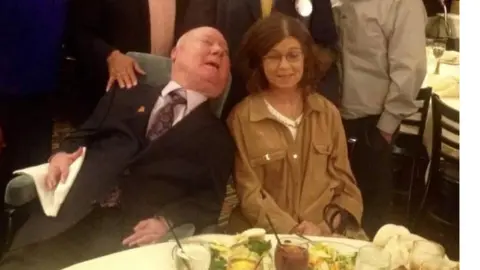 Rotary Club of Park Cities Dallas
Rotary Club of Park Cities DallasAs his confidence and strength grew, he was able to spend increasingly longer periods out of the iron lung. This allowed him to begin to experience a bit more of life. He was allowed to venture into the neighbourhood in his wheelchair with childhood friends, returning to the iron lung when he was tired.
“He was just a normal brother to me. We fought, we played, we loved, we partied, we went to concerts together – he was just a normal brother,” says Philip.
Paul finished school at home and went on to earn a college degree before setting his sights on law school.
 University of Texas
University of TexasPhilip recalls Paul’s time at the University of Texas in Austin as being “incredible”. His parents helped Paul move in with his iron lung, and then he was on his own – with limited help at first, after the carer he had hired failed to show up.
“He didn’t really have any caregivers. He was in the dorm and different people just took care of him accidentally. They pushed him around campus [in his wheelchair],” says Philip.
Paul went on to practise law in downtown Dallas. He had to deal with the surprise of clients on entering his office and seeing him in his iron lung.
“It’s not an easy thing to see, just a head sticking out,” says Philip. “People immediately go into shock. I saw that happen a lot.”
Paul lived alone for much of his adult life, no mean feat for someone unable to take care of his basic human needs like using the toilet or getting a drink on his own.

Philip says he became the master of his own domain, helping people to help him.
“He needed a unique type of care. Not even professionals are trained to take care of a quadriplegic in an iron lung,” says Philip of the huge responsibility that came with supporting his brother.
“Most of the care was basic – shaving and feeding for example. But to move him you needed to be careful not to jam his finger and so on.”
There was no instruction manual for those who answered Paul’s adverts for caregivers.
“They learned as they went,” says Philip. “And many left after a day or two. I remember going around once and asking a couple of assisted living centres if they could care for him, and the looks on their faces were priceless.”
Paul had one carer who was in his life for decades. When Kathy Gaines died, her passing left Paul bereft.
Philip says he always saw himself as the back-up carer for his brother, but he admired the support system Paul built: “He had a lot of wonderful friends, some really beautiful people in his life.”
Help needed
One of those people came into Paul’s life in a moment of dire need.
In 2015, his iron lung began to leak. As the machines were by now extremely rare, it was a race against time to find someone able to carry out the vital repair job to make it airtight once more.
After a plea was posted on social media, responses came in from around the world. But the solution turned out to be much closer to home.
Ten miles down the road from Paul’s apartment in Dallas, was the mechanical durability business Environmental Testing Laboratory, owned by Brady Richards.
Mr Richards had come into possession of two iron lung machines at a building clearance and he recalls how one day a paramedic walked in asking: “Is this the place I can find iron lungs?”
The medic had been transporting Paul to and from hospital, as carers fought to keep him alive in the failing iron lung. As the situation became more desperate, word of mouth had brought her to Mr Richards.
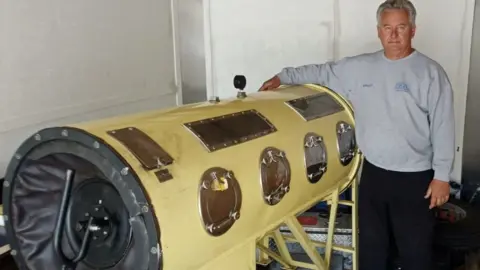 Brady Richards
Brady Richards“I did not have any idea about Paul Alexander at that time,” says Mr Richards. On learning about the emergency, he immediately set about rebuilding one of the broken machines he had in his warehouse.
He built some parts from scratch and scavenged others from other devices, learning as he went along: “Iron lungs are very robust machines. They are built to last.
“It’s a simple machine so I managed to work it out. You can increase and decrease the breathing rate and the pressure. Paul always liked the settings up high.”
Once the refurbished machine was ready, Mr Richards swapped it for the damaged one at Paul’s apartment. He wouldn’t accept any money for his work.
But that wasn’t the end of the story. Later that night Mr Richards received a call from Paul’s carer to say the machine wasn’t working.
Mr Richards returned to Paul’s apartment and quickly realised the neck collar wasn’t on properly and had come loose.
“Paul was saying ‘I’m fine, I’m OK’ as we worked to correct the problem,” recalls Mr Richards. “The truth was, he was turning blue.”
In moments of desperation like these, Paul had access to more portable breathing devices, which used a different sort of technology to the iron lung.
“Positive pressure respirators can make the patient feel like they have their head stuck out of the car window. Not everyone likes that sensation” explains Dr Patrick Murphy, the clinical lead consultant at the Lane Fox respiratory unit at St Thomas’ Hospital, in London.
Paul never moved full-time to these mask-based devices.
Another polio survivor, living in York, in northern England, did make the switch.
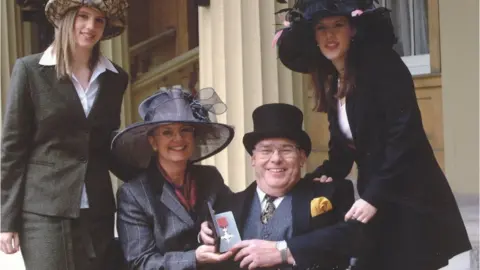 James Porteous
James PorteousJames Porteous, 78, was infected with polio in the same year as Paul. He was initially placed in an iron lung.
He recovered to a point where he could live his life without significant breathing support, but as is often the case for polio survivors, as he aged he began to need more help.
He now uses a respirator mask for about 17 hours a day: “I don’t remember much about being in the iron lung. I was also placed in a head-to-toe plaster cast initially as the thought was that this would prevent my limbs from becoming deformed,” says Mr Porteous, who is the regional president of the British Polio Fellowship.
Mr Porteous had a long career, first in stockbroking and then in various senior roles for Rowntree’s, which became part of Nestlé. He married and has four daughters. He travelled the world and in 2001 he was awarded an MBE for services to the community.
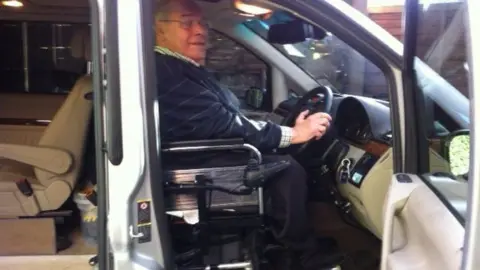 James Porteous
James Porteous“I could have sat all my life with a rug over my knees, but I decided to just get on with it. I’m tired these days and I don’t get out much any more, but life is good. I have a nice family and good friends. One thing I’d still like to see achieved in my lifetime is the complete eradication of polio around the world,” he says.
Ending polio globally was also Paul’s ambition. He wrote about it in his 2020 memoir, which he typed himself, using a pencil attached to a stick gripped in his mouth to reach the computer keyboard.
Philip says it was after the book was published that he fully realised what an inspiration his brother was to people around the world: “His personality had a lot to do with how much he was admired. He had that great big smile and he was such a welcoming, warm person. He made people comfortable.”
Brady Richards remained involved in Paul’s life over the years. He helped Paul move apartments when needed, and serviced the iron lung regularly: “It was always a pleasure to be around Paul – he had a very upbeat and positive attitude.”
 NHS
NHSDr Murphy is full of admiration for the people who cared for Paul.
“His parents took their son home in a machine that was at the time relatively high-end technology. He also had a tracheostomy, which calls for special care. They will have needed to be engineers, nurses and doctors.
“If you speak to lots of trained doctors or nurses they won’t be confident in managing a patient with complex respiratory failure, and yet patients like Paul and their families do it at home on their own. The bravery cannot be underestimated,” says Dr Murphy.
World record
Last year Paul was recognised by Guinness World Records as the person who had lived the longest in an iron lung.
Philip’s admiration for his brother runs deep: “I saw him go through a lot of struggles in his life. I’m going to miss him. I called him when I needed to talk to someone about any kind of problem I had.”
He says that while the rest of the world might be amazed by how long his brother survived in his iron lung, his parents would not have been: “They believed in him. They gave him so much strength and love. They wouldn’t have been shocked.”





